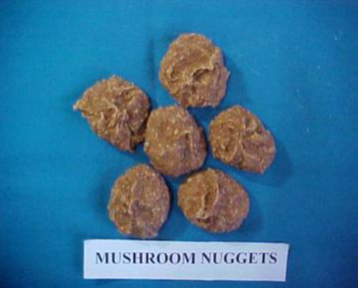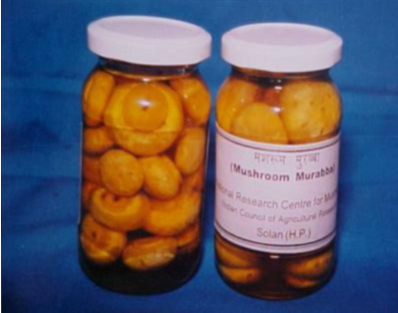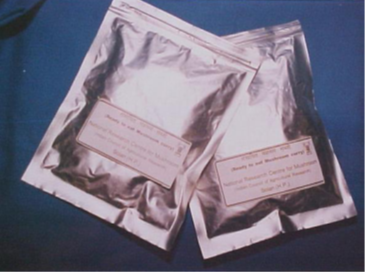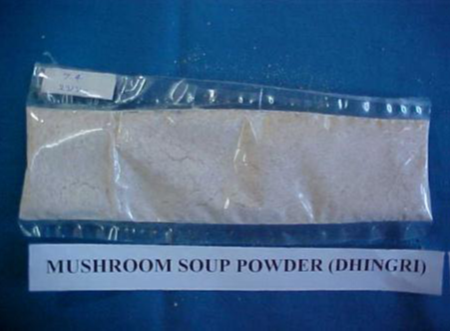The focus of Indian mushroom industry is predominantly on trade of the fresh produce rather than the real value-addition. Almost entire domestic trade is in the fresh form while most of the export is in the preserved form (canned or steeped). Current era is characterized by greater awareness about quality and, above all, with the demand for the readymade or ready-to-make food products. As mushrooms contain high moisture and are delicate in texture, these cannot be stored for more than 24 hours at the ambient conditions of the tropics. This leads to weight loss; veil opening, browning, liquefaction and microbial spoilage of the product making it unsaleable. Effective processing techniques will not only diminish the post harvest losses but also result in greater remuneration to the growers as well as processors. Value can be added to the mushrooms at various levels, right from grading to the readymade snacks or the main-course item. Improved and attractive packaging is another important but totally neglected area in mushrooms- it is still unprinted plain polypouches whereas attractive and labelled over-wrapped trays are in vogue in the developed countries. Real value-added product in the Indian market is the mushroom soup powder. Technologies for production of some other products like mushroom based biscuits, nuggets, preserve, noodles, papad, candies and readymade mushroom curry in retort pouches have been developed but are yet to be popularized. Attractive packaging of the value-added products is yet another area which may be called the secondary value-addition. While small growers may add value by grading and packaging, industry may go for the processed products for better returns as well as improvement in the demand, which shall have cascading positive effect on the production.
A. Mushroom soup powder
Soups are commonly used as appetizers but also as main course by the diet-conscious. Experiments were conducted at DMR, to prepare good quality ready-to-make mushroom soup powder using quality mushroom powder produced from the button mushroom and oyster mushroom dried in the dehumidifying air cabinet-drier.
Dried button mushroom slices or whole oyster mushrooms were finely ground in a pulveriser and passed through 0.5 mm sieve. Mushroom soup powder is prepared by mixing this powder with milk power, corn flour and other ingredients.
The detailed process flow chart for the preparation of mushroom soup powder is given below. This has to be mixed with equal quantity of water for the preparation of good quality mushroom soup with characteristic aroma and taste The mushroom soup powder can be made by using the vacuum concentrated whey, a byproduct of dairy industry.
| Button mushroom soup powder |
Oyster mushroom soup powder |
Mushroom Biscuit
Delicious and crunchy mushroom biscuits were prepared by using the button/oyster mushroom powder and various ingredients viz., maida, sugar, ghee (bakery fats), mushroom powder, coconut powder, backing soda, ammonium bicarbonate and milk powder. For making biscuits entire ingredients were finely ground using Electric Mixture and cleaned with the help of fine sieve separately. The ingredients viz., ghee and sugar were well mixed for 5-7 minutes using Dough kneeder to make the mixture homogenous. These ingredients were added to dough kneeder for dry mixing of 20-25 minutes. Thereafter, 500 ml water was added to kneeder to make dough cohesive and homogenous and continued for next 10-15 minutes. After that dough was kept for 10 minutes under the wet cloths to make it cool. Thereafter, thin sheets of dough (1.25 cm thick) were made and cut into different shapes of biscuits using different steel dies. These raw cut biscuits were kept in the steel trays in systematic manner and then these trays were shifted to hot oven (180C) for baking purpose. After 20 minutes, baking trays were removed from the hot oven and after cooling the biscuits were ready to packaging and serve. The ingredient like sugar gives desired sweetness, ghee gives smoothness and ammonium bichromate gives the crunchiness to the biscuits.
Mushroom nuggets
Nuggets are generally prepared out of „pulse‟ powder namely, black gram powder, soybean powder, urad dhal powder etc., and used in the preparation of vegetable curry in North India. The nuggets add taste as well as nutrients to the meal, since it is prepared from pulse powder. For preparation of mushroom nuggets, mushroom powder (dried and coarsely ground mushrooms) is mixed with the „Urad‟ dhal powder and a paste is prepared by adding required quantity of water. Ingredients and spices are added to the prepared paste and round balls of 2-4 cm diameters are made out of the paste. The prepared balls are spread over a steel tray and are dried by sun-drying method and thus the mushroom nuggets are prepared.
These nuggets can be relished in two ways: straightaway this can be deep-fried and used as snacks or can be used in vegetable curry preparation along with suitable vegetables or alone.
 |
| Mushroom Nuggets |
Mushroom ketch-up
Ketch-up is a common and popular product relished for its typical taste and texture as accompaniment with snacks. It is made by concentrating the juice/ pulp of the fruits/ vegetables without seeds and pieces of skin, as the skin and seed spoil the appearance of the ketch-up. It does not flow freely and is highly viscous in nature. They also contain more of sugar and less of acid. Freshly harvested button mushrooms are washed, sliced and cooked in 50% of water for 20 minutes. Mushroom paste is prepared using a mixer grinder. Arrarote (0.2%), acetic acid (1.5%) and other ingredients (as given below) are mixed in the paste and cooked to bring its TSS to 35Brix. Then the ketch-up is filled in the sterilized bottles or jars.
 |
| Mushroom ketch-up |
Mushroom candy
A fruit or vegetable impregnated and coated with sugar, subsequently taken out and dried is called a candied fruit or vegetable. The process for making candy is practically the same as that employed in the case of mushroom preserve described elsewhere, with the difference that the produce is impregnated with a higher concentration of sugar. The total sugar content of the impregnated produce is kept at about 75% to prevent fermentation.
Fresh mushrooms after harvesting are washed and halved longitudinally into two pieces. Halves are blanched for 5 min in 0.05% of KMS solution. After draining for half an hour these are treated with sugar. Sugar treatment is given at the rate of 1.5 kg sugar per kg of blanched mushroom. Initially sugar has to be divided into three equal parts. On the first day, blanched mushrooms are covered with one part of sugar and kept for 24 h. Next day, the same mushrooms are covered with second part of sugar and are kept over night and on the third day mushrooms are removed from the sugar syrup. The sugar syrup is boiled with 3rd part of sugar and 0.1% of citric acid to bring its concentration up to 70°Brix. Mushrooms are mixed with this syrup and again the contents are boiled for 5 min to bring its concentration upto 72°Brix. After cooling, the mushrooms are removed from the syrup and drained for half an hour. The drained mushrooms are placed on the sorting tables to separate, to reject defective and unwanted pieces. Finally mushroom pieces are subjected to drying in a cabinet dryer at 60°C for about 10 h. As soon as these become crispy, all mushrooms are taken out, packed in polypropylene bags and sealed. The mushroom candy can be stored up to 8 months with excellent acceptability and good chewable taste.
Mushroom preserve (Murabba)
Murabba (preserve) is made from matured fruit or vegetable, by cooking it whole or in the form of pieces in heavy sugar syrup, till it becomes tender and transparent. In murabba preparation, around 45 kg of fruit or vegetable is used for every 55 kg of sugar and cooking is continued till a concentration of at least 68% of soluble solid is reached. Fresh button mushrooms are graded, washed, pricked and blanched in 0.05% KMS solution for 10 min. It is treated with 40% of its weight of sugar daily for 3 days. Then, mushrooms are taken out from the syrup and 0.1% citric acid and remaining 40% of sugar is mixed in the syrup. After bringing its concentration to 65Brix, mushrooms are added in the syrup and good quality murabba is prepared
 |
| Mushroom Murabba |
Pickle
Mushrooms for pickling are either blanched or fried in oil till brown depending upon taste; various condiments as per local preferences and practices are also ground or fried in oil separately and added to the mushroom. The contents are mixed thoroughly and cooked slightly for few minutes. It is allowed to cool and then filled in the jars (lugs) of desired size. Vinegar may be added for taste and longer storage and the contents in the bottle or the container should be topped up with oil.
According to a formulation developed and standardized at the DMR and its coordinating centers, mushrooms are washed, sliced and blanched for 5 min in 0.05% KMS solution. The blanched mushrooms are washed in cold water for 2-3 times and the excess water is drained off. Then the mushrooms are subjected to salt curing process, in which 10% sodium chloride is added and kept over night. The excess water oozed-out of mushroom is removed on the next day and spices & preservatives are mixed to the desired taste and quality of mushroom pickle. The various spices namely turmeric powder, black mustard seed powder (rai), red chilly powder, cumin seed powder, fenugreek seed powder, aniseed powder (suwa/ shopa), black pepper, carom seed (ajwain), nigella seed (kalonji), fennel seed powder (saunf) and mustard oil are added to prepare tasty pickle. Acetic acid and sodium benzoate within the permitted limits are used as preservatives.
This pickle can be stored upto one year in the lug bottles. Good quality pickle can also be prepared from oyster mushroom. Cleaned mushrooms are blanched in hot water (80oC for 5 min), rapidly cooled and added to 60% brine to obtain mushroom to brine ratio of 7:3 by volume. The mixture is maintained at 15-20oC for 15 days for fermentation and further kept at 0-4oC to obtain a pH of 3.9. Sugar is added to the preparation at the rate of 3.3% by weight to the brine and final salt concentration reached to 6.6 per cent by weight. Studied on the suitability of Pleurotus spp. for pickle preservation reported that the product could be stored for a minimum period of 6 months at the ambient temperature (22-34oC) without any off flavour. The pickle prepared from paddy straw mushroom having also good keeping quality.
Mushroom chips
The freshly harvested button mushrooms are washed, sliced (2 mm) and blanched in 2% brine solution. The mushrooms are dipped overnight in a solution of 0.1% of citric acid + 1.5% of NaCl + 0.3% of red chilly powder. After draining off the solution, the mushrooms are subjected to drying in cabinet dryer at 60oC for 8 h. Then it is fried in the refined oil and good quality chips are prepared. Garam masala and other spices can be spread over the chips to enhance the taste. After spices mixing, the chips are packed in polypropylene packets and sealed after proper labelling.
I. Ready-to-serve mushroom curry
In view of the growing market for the readymade / ready-to-eat food items and keeping in mind the popularity of the Indian Curry world over, a technology was developed at DMR, Solan for production of “Mushroom curry in flexible-retortable pouches”. Flexible retort pouch is an ideal alternate to metal containers for packing and storage of heat processed foods. Flexible retort pouches, besides being cheaper, have many other advantages-easy bulk packing and transport, sale and very convenient to the end-user. The retort pouch of 105 um thick with polypropylene outer layer (80 μ), aluminium middle layer (12.5 μ) and polyester inner layer (12.5 μ) available in the market was used for packing mushroom curry.
In a frying pan, oil was added and heated. Sliced onions and green chillies were added to the oil and fried till golden brown. Garlic and ginger were ground into a paste, added and lightly fried till oil reappeared. Curry powder, salt and red chilly powder were added and lightly fried. About one litre of water was added to the spices mixture and boiled till thick consistency was obtained. Hundred grams of cut mushrooms were filled in the retort pouch and 50 g of curry was added into the pouch. Then it was heat processed for FO value of 10 (final 13.2) at 121C for 43 min and cooled rapidly.
The ready-to-serve mushroom curry prepared was delicious with good taste, attractive colour and a storage life of one year. Mushroom curry was also successfully prepared from dried oyster mushroom and button mushroom after its rehydration.
 |
| Ready-to-serve mushroom curry in retort pouch pack (DMR-Process) |
Despite of above described value added products mushrooms are used for making papad, chutney powder, jam, cake, mater, dokhla, sev, idli, macroni and nodles etc.
Updated on Nov 2013 |






